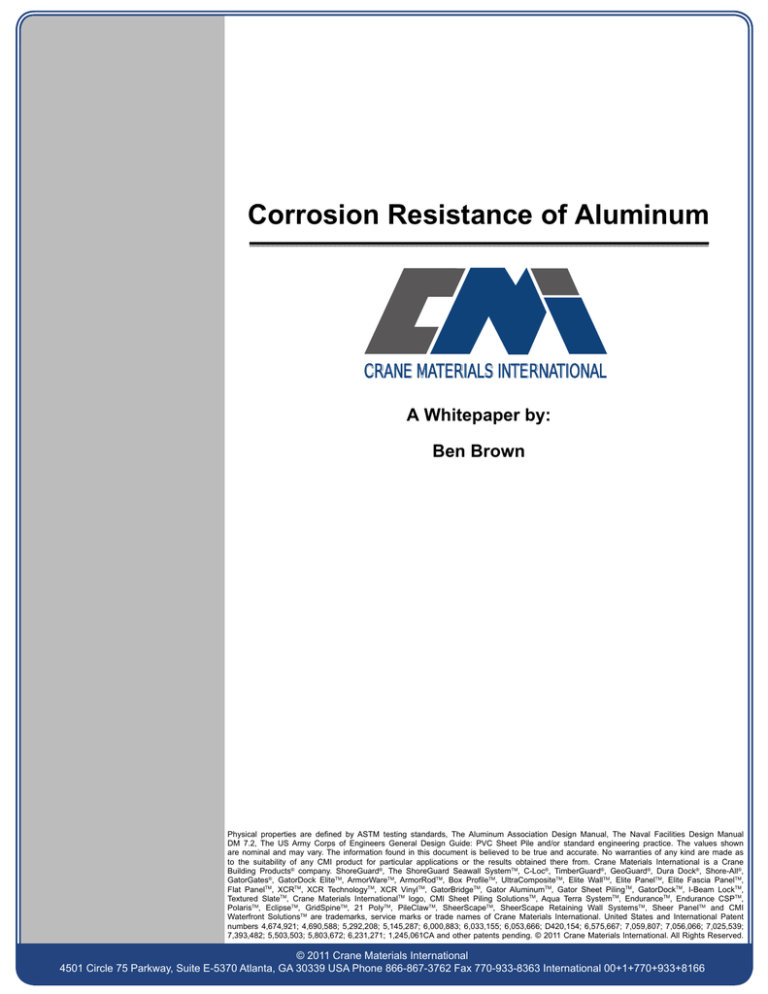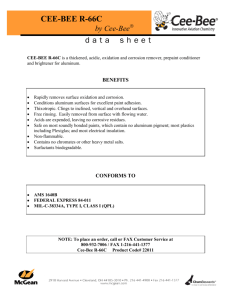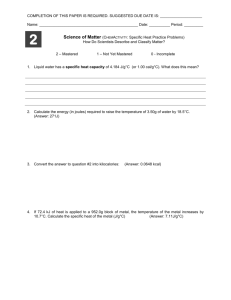
Corrosion Resistance of Aluminum
CRANE MATERIALS INTERNATIONAL
A Whitepaper by:
Ben Brown
Physical properties are defined by ASTM testing standards, The Aluminum Association Design Manual, The Naval Facilities Design Manual
DM 7.2, The US Army Corps of Engineers General Design Guide: PVC Sheet Pile and/or standard engineering practice. The values shown
are nominal and may vary. The information found in this document is believed to be true and accurate. No warranties of any kind are made as
to the suitability of any CMI product for particular applications or the results obtained there from. Crane Materials International is a Crane
Building Products® company. ShoreGuard®, The ShoreGuard Seawall SystemTM, C-Loc®, TimberGuard®, GeoGuard®, Dura Dock®, Shore-All®,
GatorGates®, GatorDock EliteTM, ArmorWareTM, ArmorRodTM, Box ProfileTM, UltraCompositeTM, Elite WallTM, Elite PanelTM, Elite Fascia PanelTM,
Flat PanelTM, XCRTM, XCR TechnologyTM, XCR VinylTM, GatorBridgeTM, Gator AluminumTM, Gator Sheet PilingTM, GatorDockTM, I-Beam LockTM,
Textured SlateTM, Crane Materials InternationalTM logo, CMI Sheet Piling SolutionsTM, Aqua Terra SystemTM, EnduranceTM, Endurance CSPTM,
PolarisTM, EclipseTM, GridSpineTM, 21 PolyTM, PileClawTM, SheerScapeTM, SheerScape Retaining Wall SystemsTM, Sheer PanelTM and CMI
Waterfront SolutionsTM are trademarks, service marks or trade names of Crane Materials International. United States and International Patent
numbers 4,674,921; 4,690,588; 5,292,208; 5,145,287; 6,000,883; 6,033,155; 6,053,666; D420,154; 6,575,667; 7,059,807; 7,056,066; 7,025,539;
7,393,482; 5,503,503; 5,803,672; 6,231,271; 1,245,061CA and other patents pending. © 2011 Crane Materials International. All Rights Reserved.
© 2011 Crane Materials International
4501 Circle 75 Parkway, Suite E-5370 Atlanta, GA 30339 USA Phone 866-867-3762 Fax 770-933-8363 International 00+1+770+933+8166
2 | C o r r o s i o n R e s i s t a n c e o f A l u m i n u m Introduction You can find a dock or seawall made of almost any construction material under the sun. However, certain materials have gained widespread acceptance while others have struggled to find their place. Aluminum, while one of the most abundant metals on earth, has made slow inroads to the construction market due in large part to the lack of available technology to capitalize on its natural advantages. With modern manufacturing and engineering procedures for aluminum now firmly established, it is no longer an experimental metal. It has gained worldwide acceptance as a dominant marine construction material and for good reason. With aluminum’s prevalence in such critical and demanding industries, why then has it seen such resistance in the U.S. for coastal applications? The answer lays in common misconceptions regarding the major causes of corrosion in the marine environment and how they affect aluminum specifically. This paper will lay out the different electro‐chemical processes that affect aluminum in the marine environment, the positive results, and the keys to overcoming negative outcomes. Aluminum is Aluminum...Right? You are probably familiar with aluminum’s reputation as a highly corrosion‐resistant material, but you may have also heard stories of, or actually experienced cases of extreme aluminum corrosion in your area. The first and single most important step towards capitalizing on aluminum’s advantages is making certain that a marine grade alloy is used. An inspection of the vast difference in corrosion‐resisting abilities of stainless steel and plain carbon steel may give some insight. As its name suggests, stainless steel is very corrosion resistant, while plain carbon steel is attacked almost immediately when exposed to the atmosphere. Just as stainless steel alloys have specific additives and properties that provide an optimum combination of strength and corrosion resistance, certain aluminum alloys are formulated for similar results. Actually, the operation that allows stainless steel to perform as it does is nearly identical to that of aluminum. 6061 and 6063 are examples of “marine grade” alloys that can achieve high strength and corrosion resistance. Conversely, another common alloy, 7075, exhibits superior strengths, over 1.5 times that of the marine grade alloys, but is much more susceptible to corrosion. This alloy sees heavy use in the aircraft industry where the environment is typically mild and aluminum corrosion isn’t likely to occur. While a high performance material in the aircraft industry, it would perform poorly in marine conditions. There are hundreds of different aluminum variations. Like steel, each exhibits different qualities and is formulated for different and specific end uses. It is imperative that the proper alloy is selected to realize aluminum’s reputation as a highly corrosion‐resistant metal in marine applications. Why is aluminum so corrosion resistant? Aluminum is actually a very active metal, meaning that its nature is to oxidize very quickly. While a weakness for most metals, this quality is actually the key to its ability to resist corrosion. When oxygen is present (in the air, soil, or water), aluminum instantly reacts to form aluminum oxide. This aluminum oxide layer is chemically bound to the surface, and it seals the core aluminum from any further reaction. This is quite different from oxidation (corrosion) in steel, where rust puffs up and flakes off, constantly exposing new metal to corrosion. Aluminum’s oxide film is tenacious, hard, and instantly self‐renewing. © 2011 Crane Materials International
4501 Circle 75 Parkway, Suite E-5370 Atlanta, GA 30339 USA Phone 866-730-9210 Fax 770-933-8363 International 00+1+770+933+8148
3 | C o r r o s i o n R e s i s t a n c e o f A l u m i n u m According to the US Army Corps of Engineers, “Aluminum has excellent corrosion resistance in a wide range of water and soil conditions because of the tough oxide film that forms on its surface. Although aluminum is an active metal in the galvanic series, this film affords excellent protection except in several special cases.”1 Is aluminum corrosion proof? The Aluminum Association states, “Unless exposed to some substance or condition which destroys this protective oxide coating, the metal remains resistant to corrosion. Aluminum is highly resistant to weathering, even in many industrial atmospheres, which often corrode other metals. It is also resistant to many acids.”2 Although aluminum has a huge advantage when compared to other metals, it is not always completely impervious to corrosion. Its protective oxide layer can become unstable when exposed to extreme pH levels. When the environment is highly acidic or basic, breakdown of the protective layer can occur, and its automatic renewal may not be fast enough to prevent corrosion. According to the US Army Corps of Engineers, aluminum’s protective “oxide film is generally stable in the pH range of 4.5 to 8.5, but the nature of the compounds present is crucial…certain soils tend to be corrosive to aluminum, particularly non‐draining clay‐organic mucks. As a general rule, contact with clay soils should be minimized unless special corrosion treatment measures are instituted.” 1 What is anodized aluminum? Annodizing is a common process used to further increase aluminum’s corrosion and abrasion resistance, as well as a method to chemically bond colorant to the surface. Anodization is achieved by artificially thickening the natural oxide layer. This film can be made many times thicker than what would otherwise be formed. Salt water DOES NOT corrode aluminum! You may have noticed that you never see aluminum corrosion in lakes, pools, food packaging products, etc. Typically, if you have seen corroded aluminum, it was in or near the ocean. While it may seem logical to draw the conclusion that the salt water must be corrosive to the aluminum, it is not. Salt water does not corrode aluminum because of its neutral pH. A saltwater solution can, however, be a major facilitator for galvanic or dissimilar metal corrosion, a more complex corrosive process. What is a galvanic (dissimilar metal) reaction? This is a basic version of a galvanic cell, much like the battery in your car. When two dissimilar metals are immersed in an electrolyte solution, a battery is created. The electrolyte solution serves as a bridge between the two metals and effectively closes half of an electrical loop. In the unlikely event that extreme pH levels or known corrosive chemicals are present and cannot be avoided, there are several simple solutions to avoid possible damage, such as anodization and cathodic protection. © 2011 Crane Materials International
4501 Circle 75 Parkway, Suite E-5370 Atlanta, GA 30339 USA Phone 866-730-9210 Fax 770-933-8363 International 00+1+770+933+8148
4 | C o r r o s i o n R e s i s t a n c e o f A l u m i n u m When the two dissimilar metals come into contact, the electrical loop is closed, and the natural voltage differential between them causes electron flow. One metal will become the anode (negative) and one will become the cathode (positive). Many versions of the galvanic series exist, and although it is a good indicator of the roles that each metal will play, and the relative intensity of the reaction, it cannot be used to predict actual reaction rates due to the many variables at play. Furthermore, there are many exceptions to the predictions made, due to real world conditions. What does this mean in the real world? To complete a galvanic cell we need metal‐to‐metal contact and an electrolyte solution. Unfortunately, salt is a very effective and abundant electrolyte. Mix it with water (the ocean) and you basically have a permanent, electrolyte solution presence in coastal areas. In the simplest terms, this electrical circuit causes the anode to lose ions and the cathode to gain ions. This process slowly consumes the anode (galvanic or dissimilar metal corrosion) and effectively strengthens the cathode against corrosion. Which metal will be the anode and how intense will the reaction be? Metals are ordered in what is known as the galvanic series. The galvanic series is a list or table that describes how reactive or noble (less reactive) different metals are likely to be. The metal nearer the noble end acts as the cathode and the metal nearer the active end acts as the anode. The farther away the two metals are from each other in the series, the larger the voltage potential, and the more intense the reaction. The intensity of the reaction is dependent on many other things as well (for example, the particular electrolyte involved and the anode to cathode ratio). Galvanic corrosion is common and a very real concern for most metals in coastal applications. In this environment, all it takes is contact between two dissimilar metals to initiate a galvanic reaction. This reaction results in galvanic corrosion for one and effective corrosion protection for the other. Severity of corrosion depends primarily on where the two metals in contact fall in the galvanic series, contact area, and the anode to cathode ratio. What does this mean for aluminum? Galvanic corrosion is the most common cause of aluminum corrosion due to its inherent resistance to more natural forms of corrosion and a lack of preventative measures taken. Aluminum is typically a reactive metal in the galvanic series. This means that in many cases, when it is in contact with other metals, aluminum will act as the anode and may begin to corrode. Although this process may take many years to yield signs of degradation, it is very easy to preclude. © 2011 Crane Materials International
4501 Circle 75 Parkway, Suite E-5370 Atlanta, GA 30339 USA Phone 866-730-9210 Fax 770-933-8363 International 00+1+770+933+8148
5 | C o r r o s i o n R e s i s t a n c e o f A l u m i n u m As a preventative measure, whenever possible, aluminum should be isolated from other metals with a non‐absorbent, non‐conductive, insulator like bitumastic paints or polymer sleeves and washers. Some common interactions between aluminum and other dissimilar metals include pressure treated wood (which contains copper), steel fasteners, and some aggregates. This is not to say that contact with these or any other metals will always cause a noticeable reaction over the life of a structure. Isolating dissimilar metals is simply a very easy and very inexpensive way of minimizing the concern of a galvanic reaction altogether. In fact, The Aluminum Association approves stainless steel as well as HDG fasteners for use with aluminum structures. Stainless steel is, however, highly preferred in coastal environments due to its superior corrosion resistance and durability over HDG. Additionally, aluminum structures typically only see peripheral contact with other metals, at worst. Contact is usually limited to fasteners and supporting members. When this is the case, the anode to cathode ratio (aluminum to dissimilar ratio) is typically very large which minimizes the negative effects of the galvanic reaction and greatly increases the life of the aluminum. Can a galvanic reaction be a good thing? (Cathodic Protection or Sacrificial Anode) So far we have addressed the negative effects of being the anode in a galvanic reaction. From before, we discovered that the material acting as the anode is subject to induced corrosion, while the cathode is additionally protected from corrosive effects. If we can force the aluminum to be the cathode, not only will it minimize the corrosive effects of the galvanic reaction, it will show even greater corrosion resisting characteristics than when left to its own devices. This principle is executed in what is known as cathodic protection or a sacrificial anode system. In the case of an aluminum seawall, rods or plates made of magnesium are electrically connected and buried, forcing a galvanic reaction, but this time the aluminum is the cathode and thus the beneficiary while the magnesium is sacrificed, hence the term sacrificial anode. In situations where soils are a concern, or major dissimilar metal contact cannot be avoided, this is a relatively inexpensive and very effective method of aluminum corrosion protection. What about “electrolysis”? When the term electrolysis is used, typically one of two phenomena is intended: a galvanic reaction, or stray current action. Although the method of corrosion between these two is similar, stray current action is induced by an external electrical current produced by improper grounding or insufficient isolation of large electric systems. Stray current corrosion is rare in aluminum waterfront structures, and in those cases, results only through improper design or installation of electrical systems in close proximity to a dock or seawall. Conclusion When aluminum’s corrosion characteristics are properly understood, it becomes easy to predict how it will behave in use. When negative effects are anticipated, solutions are inexpensive, effective, and easy to include in the design phase. Here are several tips to ensure a long lasting aluminum structure. © 2011 Crane Materials International
4501 Circle 75 Parkway, Suite E-5370 Atlanta, GA 30339 USA Phone 866-730-9210 Fax 770-933-8363 International 00+1+770+933+8148
6 | C o r r o s i o n R e s i s t a n c e o f A l u m i n u m Tips:
Always use a marine grade alloy.
Test to ensure backfills and/or native soils have a pH of 4.5‐8.5, and, when possible, avoid clays or highly organic soils.
If poorly compatible soils are anticipated or dissimilar metal contact cannot be avoided, use cathodic protection. The sacrificial anode should be checked at regular intervals, and may need to be replaced every 10 to 20 years.
Insulate contact with other materials that may have significant metal content (steel fasteners, concrete, pressure treated wood, etc.).
Use stainless steel fasteners. If stainless steel is not an option, use HDG fasteners. It is always a good idea to separate steel fasteners from the aluminum structure with polymer washers.
When economically feasible, use anodized aluminum components because of their increased corrosion protection.
Avoid grounding electrical circuits to aluminum structures when possible.
Avoid unusually high stresses or surface damage. Residual stresses may amplify corrosion. Over the last several decades the aluminum industry has developed, tested, and proven in field applications, hundreds of aluminum alloys with a variety of characteristics engineered and analyzed specifically for a given application. From aircraft to electronics to nuclear boilers to food packaging, aluminum has proven its versatility and longevity. 1.
2.
United States Army Corps of Engineers. EM 1110‐2‐
1614 Design of Seawalls and Bulkheads. Washington DC: USACE, 1995 The Aluminum Association. Specifications & Guidelines for Aluminum Structures. 8th ed. Arlington, VA: The Aluminum Association, 2005 © 2011 Crane Materials International
4501 Circle 75 Parkway, Suite E-5370 Atlanta, GA 30339 USA Phone 866-730-9210 Fax 770-933-8363 International 00+1+770+933+8148







